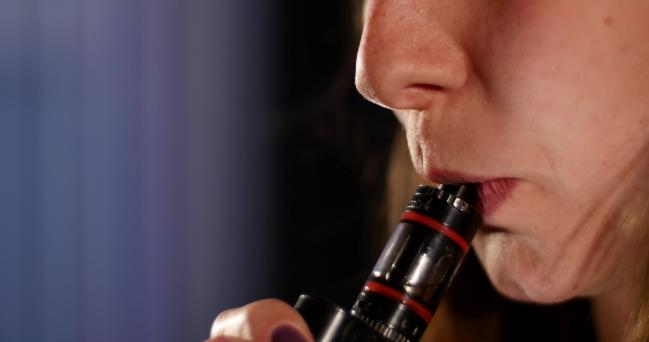Youth Use of Cigarette Alternatives May Raise Risk of Trying the Real Thing
Data on more than 10,000 teens show a strong link between experimenting with tobacco and smoking cigarettes at 1 year.

Young people who use tobacco products other than cigarettes—whether that’s in the form of hookahs, e-cigarettes, smokeless tobacco, or cigars—are twice as likely as their tobacco-free peers to be smoking the real thing 1 year later, new observational data show.
According to the analysis of more than 10,000 individuals ages 12 to 17, this relationship is cumulative: kids who used more than one of these alternative products had even greater odds of progressing to tobacco cigarettes.
“The rising popularity of noncigarette tobacco products is a new challenge for policy makers and clinicians,” senior author Benjamin W. Chaffee, DDS, PhD (University of California, San Francisco), told TCTMD via email. One “somewhat unexpected” finding in this study compared with earlier reports focusing on single products, he said, is “how similar the relationship with future smoking was across the different types of tobacco products we studied. Whether we looked at cigars, smokeless tobacco, hookah, or e-cigarettes, the increased risk of initiating cigarette smoking was consistent.”
Chaffee and co-authors Shannon Lea Watkins, PhD, and Stanton A. Glantz, PhD (University of California, San Francisco), published their results online yesterday in JAMA Pediatrics.
E-cigarettes and cigarettes may not have the same health risks relative to each other, but neither is a healthy option relative to living tobacco free. Benjamin W. Chaffee
The researchers used data from two waves of the Population Assessment of Tobacco and Health (PATH) prospective cohort study, zeroing in on participants who said that they had never smoked a cigarette at the time of study enrollment.
At baseline, 9.1% of study participants had tried at least one alternative to tobacco cigarettes and 2.2% had done so within the past 30 days. E-cigarettes were the most common, followed by hookahs, other combustibles, and smokeless tobacco.
By 1 year of follow-up, 4.6% of the youths said they had at least once smoked conventional cigarettes, with 2.1% saying they had smoked within the past 30 days. The rate of cigarette use was considerably higher among those who, at baseline, had already tried e-cigarettes (19.1%), hookahs (18.3%), noncigarette combustible tobacco like cigars (19.2%), or smokeless tobacco (18.8%).
After adjusting for potential confounders like sociodemographic, environmental, and behavioral risk factors, the investigators found that the risk of smoking within the past 30 days was approximately doubled for those who had previously used cigarette alternatives.
Smoking ≤ 30 Days Based on Noncigarette Tobacco Use 1 Year Prior
|
|
Adjusted OR (95% CI) |
|
No Product Use |
Reference |
|
E-Cigarettes |
1.87 (1.15-3.05) |
|
Hookah |
1.92 (1.17-3.17) |
|
Other Form of Combustible Tobacco |
1.78 (1.00-3.19) |
|
Smokeless Tobacco |
2.07 (1.10-3.87) |
When individuals had used more than one of these products at baseline, their risk of smoking 1 year later was nearly quadrupled in comparison to those who hadn’t tried noncigarette tobacco (adjusted OR 3.95; 95% CI 2.65-5.90).
Chaffee and colleagues point out in their paper that it’s important to consider any cigarette use, not just current use, “given that nicotine dependence can manifest in adolescents soon after their first puff, but other smoking milestones, such as daily smoking, can take years to develop.”
There is, of course, the possibility that the relationships seen here weren’t entirely causative. “It is possible that some of the adolescents who went on to smoke would have started smoking whether or not they tried noncigarette products,” Chaffee acknowledged. “However, our analysis accounted for a wide range of smoking risk factors, including age, gender, and exposure to cigarette marketing and warning labels. The associations persisted no matter how we ran the statistical models, strongly suggesting—although not necessarily proving—something causal is driving the associations.”
Importantly, “all forms of tobacco or nicotine have health risks,” he stressed to TCTMD. “E-cigarettes and cigarettes may not have the same health risks relative to each other, but neither is a healthy option relative to living tobacco free. The healthiest choice is to avoid all tobacco products, particularly for youth.”
At a policy level, the researchers say, strategies already in place to prevent cigarette smoking in young people, such as limits on pack sizes and restrictions on flavors, should be extended to other forms of tobacco.
Caitlin E. Cox is News Editor of TCTMD and Associate Director, Editorial Content at the Cardiovascular Research Foundation. She produces the…
Read Full BioSources
Watkins SL, Glantz SA, Chaffee BW. Association of noncigarette tobacco product use with future cigarette smoking among youth in the Population Assessment of Tobacco and Health (PATH) study, 2013-2015. JAMA Pediatr. 2018;Epub ahead of print.
Disclosures
- Watkins, Glantz, and Chaffee report no relevant conflicts of interest.


Comments